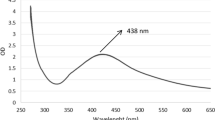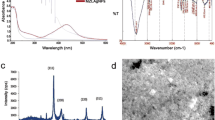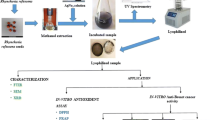Abstract
Green synthesized silver nanoparticles have significant potential in the pharmaceutical field because of their biological functions such as antioxidant and anticancer activities. Novel silver nanoparticles synthesized from Dendropanax morbifera Léveille leaves (D-AgNPs) exhibit antimicrobial activity and reduce the viability of cancer cells without affecting the viability of RAW 264.7 macrophage-like cells. In this study, we evaluated the anticancer effect of D-AgNPs by measuring the levels of reactive oxygen species (ROS) production and toxicity against A549 and HepG2 cell lines. The effect of D-AgNPs on cell migration, induction of apoptosis, and modification of gene and/or protein expression of cancer-related markers was determined using A549 cells. D-AgNPs exhibited cytotoxicity in A549 and HepG2 cell at different concentrations and enhanced the production of ROS in both cell lines. An increase in cell apoptosis and a reduction in cell migration in A549 cells were also observed after D-AgNP treatment. Furthermore, the effect of D-AgNPs in A549 cells was shown to be related to modification of the EGFR/p38 MAPK pathway. Our data provide the first evidence supporting the potential of D-AgNPs as a possible anticancer agent, particularly for the treatment of non-small cell lung carcinoma.





Similar content being viewed by others
References
Ahn S, Siddiqi MH, Aceituno VC, Simu SY, Zhang J, Perez ZEJ, Kim Y-J, Yang D-C (2015a) Ginsenoside Rg5: Rk1 attenuates TNF-α/IFN-γ-induced production of thymus-and activation-regulated chemokine (TARC/CCL17) and LPS-induced NO production via downregulation of NF-κB/p38 MAPK/STAT1 signaling in human keratinocytes and macrophages. In Vitro Cell Dev Biol Anim :1–9
Ahn S, Siddiqi MH, Noh H-Y, Kim Y-J, Kim Y-J, Jin C-G, Yang D-C (2015b) Anti-inflammatory activity of ginsenosides in LPS-stimulated RAW 264.7 cells. Sci Bull 60:773–784
Chao DT, Korsmeyer SJ (1998) BCL-2 family: regulators of cell death. Annu Rev Immunol 16:395–419
Collins TJ (2007) ImageJ for microscopy. BioTechniques 43:25–30
Conde J, Doria G, Baptista P (2012) Noble metal nanoparticles applications in cancer. J Drug Deliv 2012:751075. doi:10.1155/2012/751075
Dubon MJ, Park KS (2015) Substance P enhances the proliferation and migration potential of murine bone marrow-derived mesenchymal stem cell-like cell lines. Exp Ther Med 9:1185–1191
Gebaeck T (2009) TScratch: a novel and simple software tool for automated analysis of monolayer wound healing assays (vol 46, pg 265, 2009). BioTechniques 46(6):383–383
Godar S, Ince TA, Bell GW, Feldser D, Donaher JL, Bergh J, Liu A, Miu K, Watnick RS, Reinhardt F (2008) Growth-inhibitory and tumor-suppressive functions of p53 depend on its repression of CD44 expression. Cell 134:62–73
Green DR, Reed JC (1998) Mitochondria and apoptosis. Science 281:1309
Hail N Jr, Carter B, Konopleva M, Andreeff M (2006) Apoptosis effector mechanisms: a requiem performed in different keys. Apoptosis 11:889–904
Kathiravan V, Ravi S, Ashokkumar S (2014) Synthesis of silver nanoparticles from Melia dubia leaf extract and their in vitro anticancer activity. Spectrochim Acta A Mol Biomol Spectrosc 130:116–121
Lauand C, Rezende-Teixeira P, Cortez BA, Niero E, Machado-Santelli GM (2013) Independent of ErbB1 gene copy number, EGF stimulates migration but is not associated with cell proliferation in non-small cell lung cancer. Cancer Cell Int 13:32
Levine A, Hu W, Feng Z (2006) The P53 pathway: what questions remain to be explored? Cell Death Differ 13:1027–1036
Livak KJ, Schmittgen TD (2001) Analysis of relative gene expression data using real-time quantitative PCR and the 2− ΔΔCT method. Methods 25:402–408
Luo M, Liu X, Zu Y, Fu Y, Zhang S, Yao L, Efferth T (2010) Cajanol, a novel anticancer agent from Pigeonpea [Cajanus cajan (L.) Millsp.] roots, induces apoptosis in human breast cancer cells through a ROS-mediated mitochondrial pathway. Chem Biol Interact 188:151–160
Lurje G, Lenz H-J (2009) EGFR signaling and drug discovery. Oncology 77:400–410
Perego P, Giarola M, Righetti SC, Supino R, Caserini C, Delia D, Pierotti MA, Miyashita T, Reed JC, Zunino F (1996) Association between cisplatin resistance and mutation of p53 gene and reduced bax expression in ovarian carcinoma cell systems. Cancer Res 56:556–562
Peverelli E, Olgiati L, Locatelli M, Magni P, Fustini MF, Frank G, Mantovani G, Beck-Peccoz P, Spada A, Lania A (2010) The dopamine–somatostatin chimeric compound BIM-23A760 exerts antiproliferative and cytotoxic effects in human non-functioning pituitary tumors by activating ERK1/2 and p38 pathways. Cancer Lett 288:170–176
Sankar R, Karthik A, Prabu A, Karthik S, Shivashangari KS, Ravikumar V (2013) Origanum vulgare mediated biosynthesis of silver nanoparticles for its antibacterial and anticancer activity. Colloids Surf B: Biointerfaces 108:80–84
Siegel R, Ma J, Zou Z, Jemal A (2014) Cancer statistics, 2014. CA Cancer J Clin 64:9–29
Singh P, Kim YJ, Wang C, Mathiyalagan R, El-Agamy Farh M, Yang DC (2015a) Biogenic silver and gold nanoparticles synthesized using red ginseng root extract, and their applications. Artif cells Nanomed Biotechnol 1–6. doi:10.3109/21691401.2015.1008514
Singh P, Kim YJ, Yang DC (2015b) A strategic approach for rapid synthesis of gold and silver nanoparticles by Panax ginseng leaves. Artif Cells Nanomed Biotechnol 1–9. doi:10.3109/21691401.2015.1115410
Supino R, Perego P, Gatti L, Caserini C, Leonetti C, Colantuono M, Zuco V, Carenini N, Zupi G, Zunino F (2001) A role for c-myc in DNA damage-induced apoptosis in a human TP53-mutant small-cell lung cancer cell line. Eur J Cancer 37:2247–2256
Sur I, Altunbek M, Kahraman M, Culha M (2012) The influence of the surface chemistry of silver nanoparticles on cell death. Nanotechnology 23:375102
Vasanth K, Ilango K, MohanKumar R, Agrawal A, Dubey GP (2014) Anticancer activity of Moringa oleifera mediated silver nanoparticles on human cervical carcinoma cells by apoptosis induction. Colloids Surf B: Biointerfaces 117:354–359
Acknowledgments
This work was supported by the Korea Institute of Planning and Evaluation for Technology in Food, Agriculture, Forestry and Fisheries, Republic of Korea (313038-03-2-SB010).
Author information
Authors and Affiliations
Corresponding author
Additional information
Editor: Tetsuji Okamoto
Rights and permissions
About this article
Cite this article
Castro Aceituno, V., Ahn, S., Simu, S.Y. et al. Silver nanoparticles from Dendropanax morbifera Léveille inhibit cell migration, induce apoptosis, and increase generation of reactive oxygen species in A549 lung cancer cells. In Vitro Cell.Dev.Biol.-Animal 52, 1012–1019 (2016). https://doi.org/10.1007/s11626-016-0057-6
Received:
Accepted:
Published:
Issue Date:
DOI: https://doi.org/10.1007/s11626-016-0057-6




